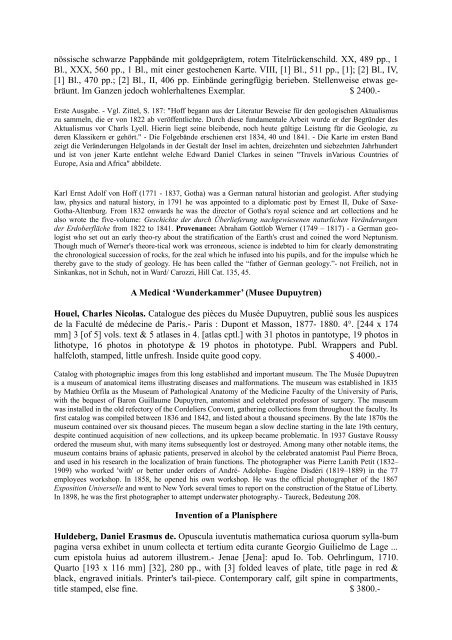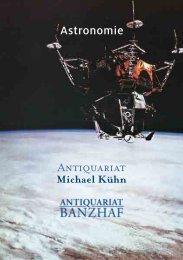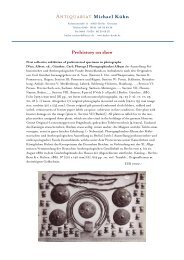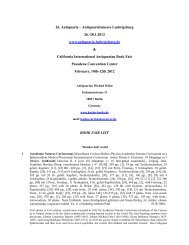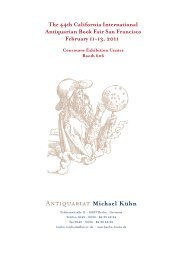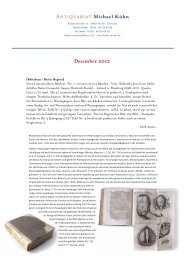List New York Antiquarian Book Fair - Antiquariat - Michael Kühn
List New York Antiquarian Book Fair - Antiquariat - Michael Kühn
List New York Antiquarian Book Fair - Antiquariat - Michael Kühn
You also want an ePaper? Increase the reach of your titles
YUMPU automatically turns print PDFs into web optimized ePapers that Google loves.
nössische schwarze Pappbände mit goldgeprägtem, rotem Titelrückenschild. XX, 489 pp., 1<br />
Bl., XXX, 560 pp., 1 Bl., mit einer gestochenen Karte. VIII, [1] Bl., 511 pp., [1]; [2] Bl., IV,<br />
[1] Bl., 470 pp.; [2] Bl., II, 406 pp. Einbände geringfügig berieben. Stellenweise etwas gebräunt.<br />
Im Ganzen jedoch wohlerhaltenes Exemplar. $ 2400.-<br />
Erste Ausgabe. - Vgl. Zittel, S. 187: "Hoff begann aus der Literatur Beweise für den geologischen Aktualismus<br />
zu sammeln, die er von 1822 ab veröffentlichte. Durch diese fundamentale Arbeit wurde er der Begründer des<br />
Aktualismus vor Charls Lyell. Hierin liegt seine bleibende, noch heute gültige Leistung für die Geologie, zu<br />
deren Klassikern er gehört." - Die Folgebände erschienen erst 1834, 40 und 1841. - Die Karte im ersten Band<br />
zeigt die Veränderungen Helgolands in der Gestalt der Insel im achten, dreizehnten und siebzehnten Jahrhundert<br />
und ist von jener Karte entlehnt welche Edward Daniel Clarkes in seinen "Travels inVarious Countries of<br />
Europe, Asia and Africa" abbildete.<br />
Karl Ernst Adolf von Hoff (1771 - 1837, Gotha) was a German natural historian and geologist. After studying<br />
law, physics and natural history, in 1791 he was appointed to a diplomatic post by Ernest II, Duke of Saxe-<br />
Gotha-Altenburg. From 1832 onwards he was the director of Gotha's royal science and art collections and he<br />
also wrote the five-volume: Geschichte der durch Überlieferung nachgewiesenen naturlichen Veränderungen<br />
der Erdoberfläche from 1822 to 1841. Provenance: Abraham Gottlob Werner (1749 – 1817) - a German geologist<br />
who set out an early theo-ry about the stratification of the Earth's crust and coined the word Neptunism.<br />
Though much of Werner's theore-tical work was erroneous, science is indebted to him for clearly demonstrating<br />
the chronological succession of rocks, for the zeal which he infused into his pupils, and for the impulse which he<br />
thereby gave to the study of geology. He has been called the “father of German geology.”- not Freilich, not in<br />
Sinkankas, not in Schuh, not in Ward/ Carozzi, Hill Cat. 135, 45.<br />
A Medical ‘Wunderkammer’ (Musee Dupuytren)<br />
Houel, Charles Nicolas. Catalogue des pièces du Musée Dupuytren, publié sous les auspices<br />
de la Faculté de médecine de Paris.- Paris : Dupont et Masson, 1877- 1880. 4°. [244 x 174<br />
mm] 3 [of 5] vols. text & 5 atlases in 4. [atlas cptl.] with 31 photos in pantotype, 19 photos in<br />
lithotype, 16 photos in phototype & 19 photos in phototype. Publ. Wrappers and Publ.<br />
halfcloth, stamped, little unfresh. Inside quite good copy. $ 4000.-<br />
Catalog with photographic images from this long established and important museum. The The Musée Dupuytren<br />
is a museum of anatomical items illustrating diseases and malformations. The museum was established in 1835<br />
by Mathieu Orfila as the Museum of Pathological Anatomy of the Medicine Faculty of the University of Paris,<br />
with the bequest of Baron Guillaume Dupuytren, anatomist and celebrated professor of surgery. The museum<br />
was installed in the old refectory of the Cordeliers Convent, gathering collections from throughout the faculty. Its<br />
first catalog was compiled between 1836 and 1842, and listed about a thousand specimens. By the late 1870s the<br />
museum contained over six thousand pieces. The museum began a slow decline starting in the late 19th century,<br />
despite continued acquisition of new collections, and its upkeep became problematic. In 1937 Gustave Roussy<br />
ordered the museum shut, with many items subsequently lost or destroyed. Among many other notable items, the<br />
museum contains brains of aphasic patients, preserved in alcohol by the celebrated anatomist Paul Pierre Broca,<br />
and used in his research in the localization of brain functions. The photographer was Pierre Lanith Petit (1832–<br />
1909) who worked 'with' or better under orders of André- Adolphe- Eugène Disdéri (1819–1889) in the 77<br />
employees workshop. In 1858, he opened his own workshop. He was the official photographer of the 1867<br />
Exposition Universelle and went to <strong>New</strong> <strong>York</strong> several times to report on the construction of the Statue of Liberty.<br />
In 1898, he was the first photographer to attempt underwater photography.- Taureck, Bedeutung 208.<br />
Invention of a Planisphere<br />
Huldeberg, Daniel Erasmus de. Opuscula iuventutis mathematica curiosa quorum sylla-bum<br />
pagina versa exhibet in unum collecta et tertium edita curante Georgio Guilielmo de Lage ...<br />
cum epistola huius ad autorem illustrem.- Jenae [Jena]: apud Io. Tob. Oehrlingum, 1710.<br />
Quarto [193 x 116 mm] [32], 280 pp., with [3] folded leaves of plate, title page in red &<br />
black, engraved initials. Printer's tail-piece. Contemporary calf, gilt spine in compartments,<br />
title stamped, else fine. $ 3800.-


